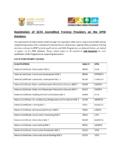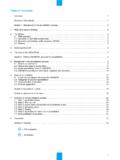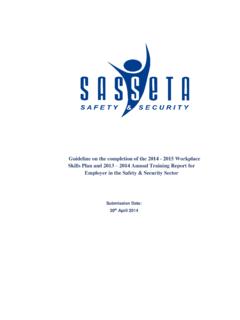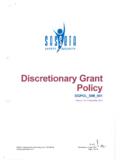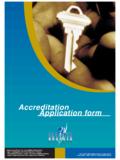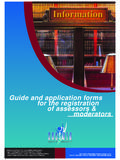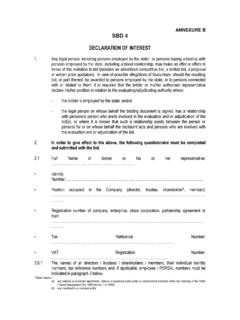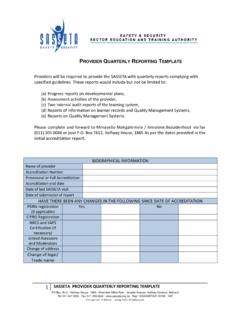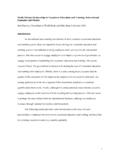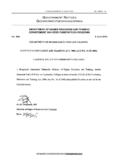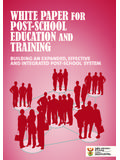Transcription of SECTOR SKILLS PLAN FOR THE SAFETY AND SECURITY: …
1 SECTOR SKILLS PLAN FOR THE SAFETY AND security : 2017 - 18 UPDATE 01ST AUGUST 2016 i FOREWORD On the 12th February 2015, the Minister of Education and Training (DHET) placed the SAFETY and security SECTOR Education and Training Authority (SASSETA) under administration as a result of constant levels of poor financial and operational performance. The Minister subsequently appointed an administrator for a period of 12 months. On the 3rd February 2016, he then extended the administration period by 12 months ending on the 12th February 2017 . As part of the turnaround strategy of SASSETA, the administration team in conjunction with management have put in place various interventions and process aimed at addressing and improving both financial and operational systems. Critical to this process has been improving SASSETA SKILLS planning capacity, improving data integrity and management processes.
2 Various measures have now been put in place to address all the systemic challenges that led to inadequacies in the planning and reporting processes within SASSETA. Amongst these, was a revision of all planning processes within SASSETA including revisions to the SKILLS SECTOR Plan (SSP), the Strategic Business Plan and the Annual Performance Plan. The revision also included the introduction of operational plans, a quarterly performance management forum where performance is accessed. This SSP identifies some of the key priority SKILLS that need to be addressed but work is still required to ensure the SETA achieves a more effective and credible SSP in the next planning cycle. Further work on enhancing SKILLS planning that is still underway, this includes: Analysis of additional data sources and data triangulation, Subsector-based and labour market research, and Targeted stakeholder engagements and consultations.
3 SASSETA will continue to actively enhance SKILLS planning and reporting in support of improved SKILLS development delivery in the post-education and training system. This SSP is the outcome of, not only an ongoing research process, but of extensive stakeholder consultation and engagement. Much work has been done to align the SSP with the government priorities particularly in relation to the SAFETY and security SECTOR . The SSP draft is submitted to the Minister of Higher Education and Training in partial compliance with the requirement of the SKILLS Development Act 1998 as amended and the NSDS III. The SSP draft is here endorsed by duly authorised representative. _____ DATE: 01 August 2016 JENNIFER IRISH-QHOBOSHEANE (Ms) SASSETA ADMINISTRATOR ii EXECUTIVE SUMMARY It is important for SASSETA to understand the needs and the profile of the SAFETY and security SECTOR within the context of South African with reference to the associated issues which criss-cross the geo political and socio-economic spheres in order for it to succeed in its mandate of supporting the SKILLS development needs of the SECTOR .
4 The SAFETY and security SECTOR in South Africa is both public and private. The public security SECTOR consists of government security agencies and law enforcement bodies, whose role is to protect and serve the public and the interests of the state. The private SECTOR element of the security SECTOR comprises those companies and bodies who provide security and legal services to paying clients. The government has identified 2015/20 MTSF cycle Outcome 3: All people in South Africa are and feel safe, which incorporates the following outputs: i. Reduce overall levels of serious crimes and in particular contact crime. ii. An effective Criminal Justice System (CJS). iii. Corruption within the JCPS cluster combated to enhance its effectiveness and its ability to serve as a deterrent against crime. iv. Perceptions of crime among the population managed and improved. v. Levels of corruption reduced improving investor perception, trust and willingness to invest in South Africa.
5 Vi. Effective and integrated border management. vii. Cyber-crime combated. SASSETA has grouped its constituencies into seven subsectors: Policing, Corrections, Defence, Justice, Intelligence Activities, Legal Services, and Private security and Investigation Activities. A large number of trade unions represent the interests of workers in the SAFETY and security SECTOR . The South African government spent R158 million on its defence, public order and SAFETY function in the 2014/15 financial year. Budgets for the defence, public order and SAFETY function are however under pressure, with this evident in the declining proportion of the total government budget that is allocated to this function, as well as in the declining annual increases. The latest figure of of total consolidated government expenditure represents a decline from the proportional allocation of of the total budget in 2011/2012.
6 Looking forward over the next three years, government estimates show that by 2017 /18, spending on the defence, public order and SAFETY function will have increased to a total R 186 million, but proportionally this amount will have declined further to only of the total government expenditure. While the recent and reliable economic information is available through government budget reports on the economic performance of the state portion of iii the SAFETY and security SECTOR , recent information on the private portion of the SECTOR is difficult to accurately assess. The Private security subsector is said to be one of the largest employers in the country and is one of the fastest growing local industries. The number of registered, active security officers in the subsector increased from 411 109 in 2010/11 to 487 058 in 3013/14, which is an average annual growth of over the period.
7 Despite this, it is difficult to find detailed and/or recent figures of the subsector s economic performance. In 2012, it was estimated that the South African private security industry was worth between R50 and R55 billion rand and, from 2011 it was suggested that the subsector contributed around 2% of South Africa s GDP in the preceding years. In 2010 the legal services sub SECTOR generated a total income of R17 244 million which represented a similar of GDP. The SAFETY and security SECTOR employs 758 748 people, of which almost half (368 214) are employed in the Private security subsector. Policing is the second largest subsector, and the largest of the state SAFETY and security departments, employing just more than one quarter of the SECTOR s employees (194 824). Defence employs 10% of the SECTOR s employees (78 707), with Legal Services (51 786) and Corrections (41 476) employing 6% and 5% respectively.
8 The Justice SECTOR is the smallest subsector, employing 23 741 people or 3% of total SECTOR employment. The SAFETY and security SECTOR employs 3 170 people with disabilities. This represents of total SECTOR employment. Considering that the Legal Services subsector and the Private security and Investigation Activities subsectors have predominantly private organisations, while the remaining subsectors have predominantly public organisations, the private portion of the SAFETY and security SECTOR employs 56% of the SECTOR s workforce, while the public portion employs 44%. In the SAFETY and security SECTOR , the overwhelming majority of employees (70%) are Service and Sales Workers, with Clerks (9%) being the next largest category, followed by Technicians and Associate Professionals (6%). In the SECTOR as a whole the categories of Professionals, and Legislators, Senior Officials and Managers respectively constitute 5% and 4% of total employment.
9 This overall picture is highly influenced by the large Private security sub- SECTOR , in which 90% of employees are classified as Service and Sales Workers. In respect of gender, the SECTOR has a whole has 70% male employees and 30% female employees, a picture which is again influenced significantly by the profile of the Private security subsector, where 79% of employees are male. Around two thirds of employees are male in Policing (66%), Corrections (69%) and Defence (71%), while females dominate the Justice (58%) and Legal Services (63%) subsectors. Overall 47% of the SECTOR s employees are youth under the age of 35, while only 5% are over the age of 55. The research suggests that factors such as globalisation and technological advancements are changing the patterns of crime, which impact on SAFETY and security in South Africa. This compels the iv role players in the criminal justice system and in the broader SAFETY and security SECTOR to re-define their focus to address the changing face of crime and re-aligning their objectives to serve national imperatives.
10 The need to professionalise the SECTOR as highlighted in the NDP is also influencing the way services are delivered, and the SKILLS base required for the SECTOR such as criminologists, detectives/investigators, forensic and specialised SKILLS medical services, linguistics, forensic services, investigation, cyber crime SKILLS , management and leadership SKILLS . The occupational makeup and mix in the SECTOR shows the importance of cross-economic- sectoral occupations, including concentrations in the medical services professionals, information technology, engineers, chemists, psychologists and vocational counsellors, social workers, finance and related professionals, logistical support and related professionals, language practitioners, interpreters, and other communication, automotive and technical related professionals. The nature and extent of SKILLS supply in the SECTOR is drawn from various education and training bodies such as schools [private and public schools], Universities and University of Technologies [private and public universities], TVET colleges [private and public TVET colleges], SETA supported training programmes, and private providers as well as, very significantly, state-owned institutions within government departments.
